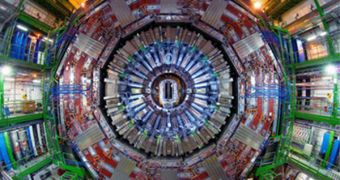A couple of weeks ago, researchers working at the Large Hadron Collider (LHC) announced the discovery of tantalizing clues that may indicate the Higgs boson. Physicists from around the world are now looking through the new data, hoping to confirm or infirm the discoveries.
The announcement was made at a meeting of the European Physical Society (EPS), held in Grenoble, France. The LHC is buried under the French-Swiss border, close to Geneva, and is operated by the European Organization for Nuclear Research (CERN).
The Standard Model predicts the existence of the Higgs boson. It indicates that the elementary particle is what allows energy to acquire mass, an attribute that makes it essential to the scientific model.
Finding it was the primary reason for why the 27-kilometer-long LHC was built. The accelerator is the most complex scientific endeavor ever attempted, and the most powerful particle accelerator on Earth.
The ATLAS (A Toroidal LHC Apparatus) and CMS (Compact Muon Solenoid) instruments are the largest detectors on the collider, and their goal is to find the Higgs. However, picking up data that may indicate the discovery from the ocean of information the accelerator produces is extremely difficult.
The LHC works by smashing proton beams accelerated to tremendous energies head-on, and looking through the resulting particles. These collisions produce massive number of known and unknown particles, of which the Higgs is only one.
Recently, CMS and ATLAS science teams reported “excess events,” with certain data spikes occurring in an energy range between 130 and 150 gigaelectronvolts (GeV). This is the expected mass range of the Higgs, as indicated by the Standard Model.
According to California Institute of Technology (Caltech) physics professor Harvey Newman, the data are not yet statistically significant enough to represent a definite signal. There are also two possible explanations for why these excess events were recorded in the first place.
One explanation is that the data spikes are simple background events of unknown origin, while the second one is that they were actually produced by the Higgs boson. “One could speculate that it's an unusual statistical fluctuation. But I don't think so,” the Caltech expert says.
Interestingly, finding the Higgs is not enough. Doing so would only circumvent some of the problems associated with the Standard Model, but not all. The model itself is not self-consistent, Newman explains. The easiest way to make sense of the particle world is through supersymmetry.
What this theory suggests is that each particle in existence has a supersymmetric counterpart. Thus far, the LHC revealed no signs of supersymmetry, but physicists are continuing their observations.

 14 DAY TRIAL //
14 DAY TRIAL //